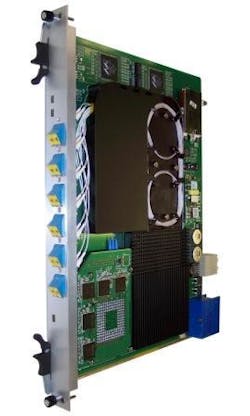FEBRUARY 26, 2008 By Stephen Hardy -- JDSU (search for JDSU) has announced a highly integrated transport technology platform, the Agile Optical Network Superblade. The new offering combines a wavelength-selective switch (WSS), EDFA, preamplification, and optical channel monitor (OCM), all managed by the new AON Embedded Operating System, into a single-slot blade. JDSU will target the Superblade at 10- and 40-Gbit/sec applications.
According to Craig Iwata, senior director of marketing and business operations, optical communications at JDSU, the company has plans to integrate additional functions into the platform, with tunable optical dispersion compensation technology among the initial candidates.
The Superblade leverages both new modules and new design concepts. For example, JDSU simultaneously announced the Nano WSS, a smaller version of its recently unveiled Mini WSS. The MEMS-based module measures 100x75x18 mm and supports configurations from 1x2 to 1x9 at 100-GHz spacing, with 50-GHz support on the horizon.
Meanwhile, JDSU designers also reconfigured the EDFA function to streamline both the parts and space required. As a result, they reduced the number of pumps required from five to three.
The OCM provides power monitoring in its initial configuration. However, Iwata and Jy Bhardwaj, vice president and general manager, agile optical networks, say that OSNR functionality is forthcoming.
The new Embedded Operation System will tie the functions together while supplying a seamless interface to the host system. The OS comprise three layers: a customizable Customer Adaptation Layer that faces the host system software, a Common OAM layer, and Optical Device Software the controls the operation of the optical elements.
Taken together, the Superblade concept will reduce costs by as much as 50% versus discrete alternatives, JDSU asserts. The blade also will decrease complexity, power requirements, optical power loss, and overall system size, the company adds.
The platform is designed to be customized for host system requirements. For example, Madhu Krishnaswamy, product line manager, optical circuit packs and subsystems, says JDSU has discussed blades with as many as 24 points and multiple WSS modules with at least one potential customer. Iwata and Bhardwaj say that JDSU is engaged with multiple customers regarding specific implementations and expects to deliver the first completed Superblades by the end of this year.
Visit JDSU
For more optical equipment design information, visit the Optical Equipment Design Center
